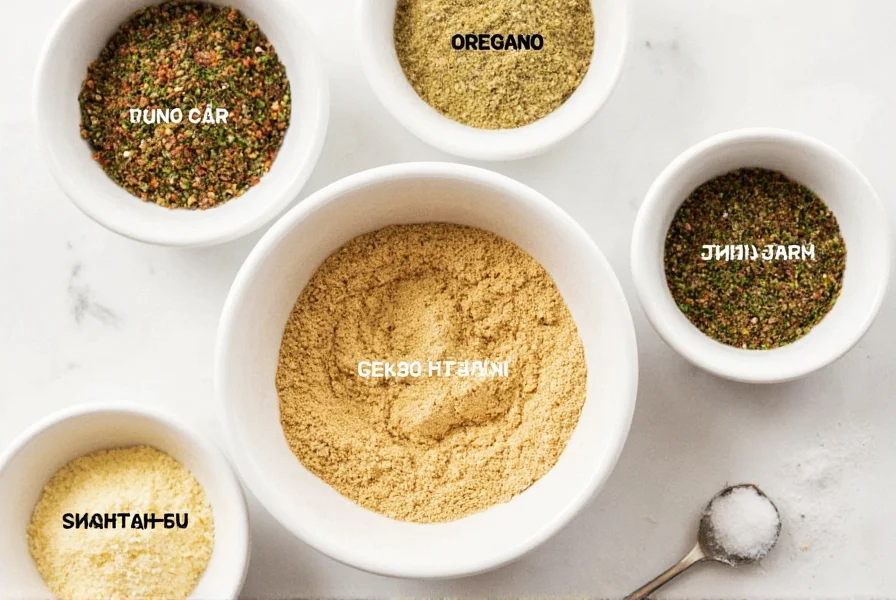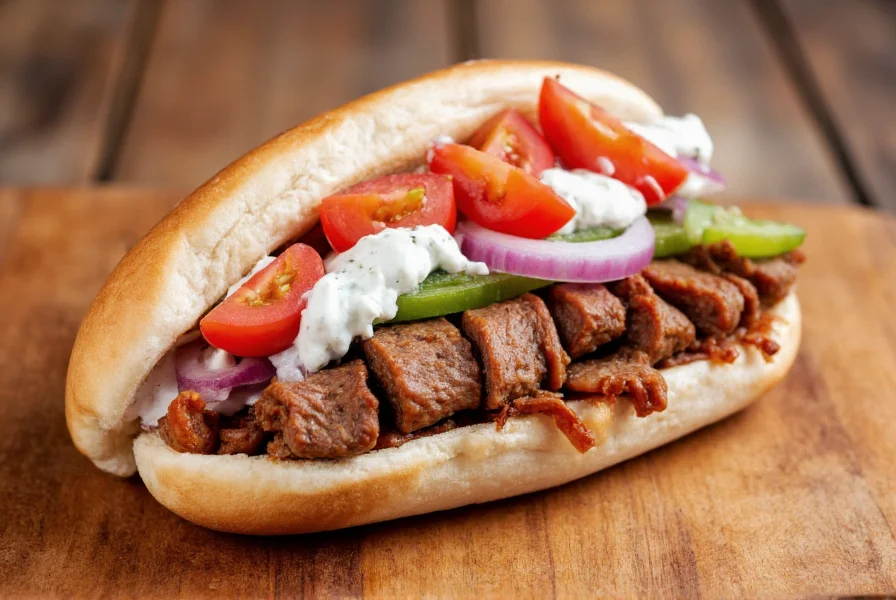Understanding the authentic components of gyro seasoning helps recreate that distinctive Mediterranean flavor profile at home. Unlike many commercial blends that add unnecessary fillers, traditional gyro seasoning relies on simple, high-quality herbs and spices that complement rather than overpower the meat.
Core Ingredients in Authentic Gyro Seasoning
The magic of gyro seasoning comes from its balanced blend of Mediterranean herbs. While regional variations exist across Greece and the Middle East, these six ingredients form the foundation of most traditional recipes:
- Dried oregano - Provides the earthy, slightly bitter backbone
- Garlic powder - Adds savory depth without burning during cooking
- Onion powder - Contributes sweetness and complexity
- Marjoram - Offers a delicate floral note distinct from oregano
- Thyme - Brings subtle lemony undertones
- Salt and black pepper - Essential for flavor enhancement
Some regional variations include mint for freshness, allspice for warmth, or a small amount of cayenne for subtle heat. The best homemade gyro seasoning avoids fillers like cornstarch or MSG that dilute the authentic flavor profile.

Creating Perfect Homemade Gyro Seasoning
Commercial gyro seasoning often contains unnecessary additives. Making your own ensures freshness and control over ingredients. This simple recipe yields enough for multiple batches of gyro meat:
| Ingredient | Measurement | Function |
|---|---|---|
| Dried oregano | 2 tablespoons | Primary flavor base |
| Garlic powder | 1½ tablespoons | Savory depth |
| Onion powder | 1½ tablespoons | Sweet complexity |
| Marjoram | 1 tablespoon | Floral note |
| Thyme | 1 tablespoon | Lemony undertone |
| Salt | 1 tablespoon | Flavor enhancer |
| Black pepper | 2 teaspoons | Warmth and bite |
| Paprika | 1 teaspoon | Color and mild sweetness |
Mix all ingredients thoroughly in a small bowl. Store in an airtight container away from light and heat. Properly stored, homemade gyro seasoning maintains peak flavor for 3-4 months. For best results, rub generously onto meat 2-4 hours before cooking to allow flavors to penetrate.
Gyro Seasoning Applications Beyond Traditional Gyros
While essential for authentic gyro meat, this versatile spice blend enhances numerous Mediterranean dishes. Many home cooks discover that understanding what is gyro seasoning made of unlocks creative culinary possibilities beyond the classic sandwich.
Use this traditional Greek gyro spice blend to elevate:
- Grilled vegetables - Toss zucchini, bell peppers, and onions with olive oil and seasoning
- Roasted potatoes - Creates flavorful Mediterranean-style potatoes
- Marinades for chicken - Particularly effective for souvlaki or grilled chicken breasts
- Tomato-based sauces - Adds depth to pasta sauces and pizza
- Homemade flatbreads - Mix into dough for flavorful pita or lavash
When using gyro seasoning for chicken, reduce the salt content slightly as poultry absorbs flavors differently than lamb or beef. The best gyro seasoning for chicken often includes a touch more lemon zest to complement the poultry's lighter flavor profile.

Distinguishing Gyro Seasoning from Similar Blends
Many Mediterranean spice blends share common ingredients, causing confusion about gyro seasoning vs tzatziki and other mixtures. Understanding these differences ensures proper usage:
- Gyro seasoning - Dry spice blend for seasoning meat before cooking
- Tzatziki - Yogurt-based sauce with cucumber, garlic, and dill (served as condiment)
- Adobo - Latin-inspired blend with stronger cumin and oregano notes
- Shawarma spice - Middle Eastern blend with more pronounced turmeric and cardamom
Unlike shawarma spice, authentic gyro seasoning contains minimal to no turmeric, which would discolor the meat yellow. The distinctive flavor comes from the specific ratio of oregano to marjoram, with Greek oregano providing the dominant note.
Maximizing Flavor with Proper Usage Techniques
Simply sprinkiling gyro seasoning on meat won't yield optimal results. For restaurant-quality flavor when preparing how to use gyro seasoning in cooking, follow these professional techniques:
- Marinating time - Allow at least 2 hours (preferably overnight) for flavors to penetrate
- Fat content - Mix seasoning with olive oil to help it adhere and carry flavors
- Layering - Apply seasoning both before and after cooking for complex flavor development
- Temperature control - Avoid high heat that burns delicate herbs
When making homemade gyro meat, combine one tablespoon of seasoning per pound of meat with 2 tablespoons of olive oil and the juice of half a lemon. This creates a paste that adheres well and keeps the meat moist during cooking.
Storage and Freshness Tips
Proper storage maintains the vibrant flavor of your homemade gyro seasoning. Unlike commercial blends that contain anti-caking agents, pure spice mixes lose potency faster. Follow these guidelines:
- Store in airtight glass container away from light and heat
- Keep away from stove or other heat sources
- Label with preparation date
- Refresh your blend every 3-4 months for peak flavor
- Consider making smaller batches more frequently
For extended storage, freeze your homemade gyro seasoning in ice cube trays covered with olive oil, then transfer to freezer bags. This preserves freshness for up to six months and provides ready-to-use portions for marinades.
Frequently Asked Questions
What is the difference between gyro seasoning and Greek seasoning?
Gyro seasoning specifically targets meat preparation for gyros with higher concentrations of oregano and garlic, while Greek seasoning is more versatile for vegetables and salads with balanced herbs. Gyro blends typically contain more garlic powder and less dill than general Greek seasoning blends.
Can I use gyro seasoning for vegetarian dishes?
Absolutely. Gyro seasoning works wonderfully with grilled vegetables, roasted potatoes, chickpeas, and mushroom dishes. For vegetarian applications, consider adding a pinch of smoked paprika to mimic the meaty depth traditionally provided by lamb or beef.
How much gyro seasoning should I use per pound of meat?
Use 1-2 tablespoons of gyro seasoning per pound of meat. For stronger flavor penetration, mix the seasoning with 1-2 tablespoons of olive oil and the juice of half a lemon to create a marinade paste that adheres well to the meat surface.
Does authentic gyro seasoning contain mint?
Traditional Greek gyro seasoning typically does not include mint, though some regional variations in the Middle East incorporate small amounts. Most authentic recipes focus on oregano, garlic, onion, marjoram, and thyme as the core flavor profile without mint's distinctive coolness.










 浙公网安备
33010002000092号
浙公网安备
33010002000092号 浙B2-20120091-4
浙B2-20120091-4